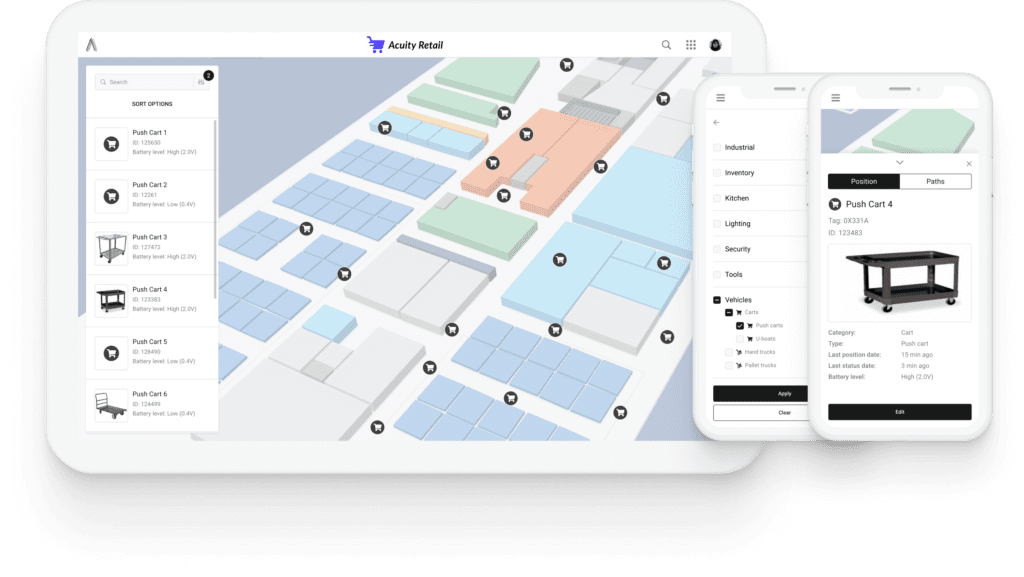Welcome to the final installment of our three-part series exploring the evolution of Indoor Positioning Systems (IPS) and wayfinding. Introducing Atrius Locator brings us full circle to understanding how innovative technology elevates our experiences with indoor spaces. If you prefer reading in chronological order, Part 1: Crossing the Chasm for IPS and Part 2: Elevating Customer Experiences are easy to find!
The inventive and various ways we use buildings today are markedly different from what indoor spaces looked and felt like 100 years ago. Rising real estate costs and increased urbanization transformed once-single purpose facilities into multi-use, built spaces. Even typically complex buildings like hospitals and airports are more advanced, thanks to necessary infrastructure updates and renovations.
And yet, modernizing our schools, entertainment venues, high rises, and corporate campuses hasn’t sufficiently answered a fundamental question most people seldom think about: what’s happening inside their building(s) at any given time?
Until now.
Introducing Atrius® Locator
Atrius Locator, our newest cloud-based solution, leverages the benefits of Indoor Positioning Systems. By implementing Atrius Locator, organizations gain historical and live data regarding physical assets in mapped spaces.
This comprehensive solution significantly improves businesses’ ability to address the known challenges of monitoring physical assets within the built environment.
Three Challenges of Managing Assets Today
Everyone from the VP of Operations to the just-hired sales associate or warehouse worker has a vested interest in quickly locating the physical assets required to do their jobs. Whether they’re preparing quarterly reports or assisting a customer, time and service matter. At any given time, team members are facing one, two, or three hurdles when it comes to managing assets:
- Locating misplaced items: Without resources to quickly find a required asset—from a bar code scanner to a forklift, customers often feel the biggest impact when workers can’t find what they need at a moment’s notice.
- Tracing the historical journey and use of items: Organizations are optimizing their digital options with deep insight into user journeys, actions, and conversions. Because this level of granularity does not exist in their physical spaces, they only have a fraction of the information they need.
- Tracking live movement within spaces: The inability to monitor when and where team members relocate physical assets, especially high-value items, is an operational and fiscal risk.
With the right technology, companies can clear these hurdles, one at a time or simultaneously, and gain greater control over physical assets and the spaces they occupy.
Atrius Locator brings digital precision to indoor spaces
Today’s technologies allow for customizable online experiences and more visibility into our digital worlds than ever. We can personalize everything from the websites we browse to the content we consume. We can’t, however, capture this same level of understanding about what is happening inside the buildings where we operate.
Atrius Locator facilitates and improves asset utilization, space utilization, operational safety, and drives down costs while achieving better customer satisfaction.
Asset Utilization
The physical assets you use to deliver services for your customers directly impact their brand experience—and your brand reputation. Ready access to dollies in hardware stores could be the difference between a sale and losing a customer. You need to know how many of which items are available and where they’re located.
Feature use case – Retail
Before implementing Atrius Locator, one of our customers didn’t know what type of shopping aids their guests used most of the time. With Atrius Locator, the richer insights revealed they needed more wheelchair-compatible shopping carts and fewer underutilized-style carts.

Space Utilization
There’s a general belief that built spaces are merely cost centers necessary to operate a business. However, we consider built environments as potential revenue sources waiting to be unlocked. With the right solutions, operators can better utilize indoor spaces, adding overall value. The missing piece to that puzzle is understanding the relationship between an indoor area and the items it contains.
Feature use case – Aviation
Airports and the airlines servicing those buildings use Atrius Locator worldwide to discover how travelers interact with their facilities. Granular insight into multiple levels of the passenger experience facilitates more efficient service, increased concessionaire revenue, and happy guests.
Operational Safety
Manufacturing and construction can be high-risk industries. Forklifts and other types of moving or heavy equipment vital to daily operations are expensive to operate and maintain. More concerning, putting people and dangerous equipment in the same space can be hazardous.
Feature use case – Manufacturing
Before Atrius Locator, preventing forklifts from entering high traffic zones and maintaining required compliance records was time-consuming . Using Atrius Locator, forklift safety and efficiency improved while tracking live movement and location reduced compliance costs.
Increasing Customer Satisfaction
The typical big box retail store averages 100,000 square feet. This means associates often spend more time wandering those 100,000 square feet looking for accessories or equipment to help customers than providing customer support. By the time they find a step stool to reach the shopper’s preferred item, the customer might have left the store, leading to a lost sale.
Use case spotlight: Customer satisfaction
Because shoppers often need assistance in larger hardware stores, Atrius embedded a consumer-focused feature in one of our customer’s branded apps. The upgrade allowed shoppers to share their exact location in the store when requesting customer assistance. Employee apps had similar functionality. Combined, these features ensure the customer receives help from the store associate best positioned to assist.
Location monitoring helps team members closest to the situation collect and deliver the customers’ requested items. In this use case, Atrius Locator improves customer satisfaction while increasing operational efficiency.

Leverage Data To Understand Your Spaces
Today’s Atrius Locator is the first of an exciting technology journey. The solution resolves common problems associated with physical asset management by:
- Saving time spent searching for lost items
- Reducing manual tasks
- Improving productivity
- Revealing deeper operational insights
- Increasing customer satisfaction
Future releases will enhance the service with geo-fences, zones, and data analysis capabilities to resolve more complex and critical business challenges. Chat with an Atrius spatial data expert today and discover what you can do for your business and customers with Atrius Locator.
